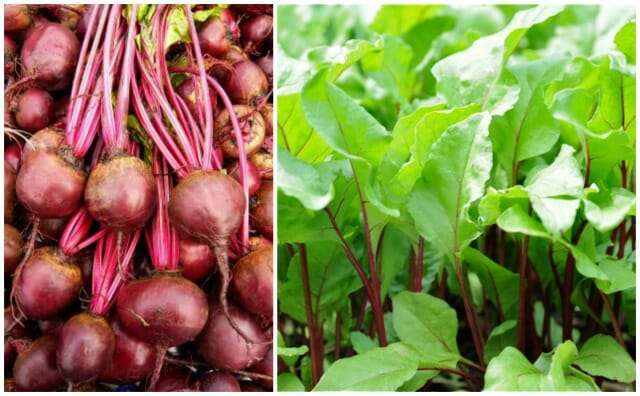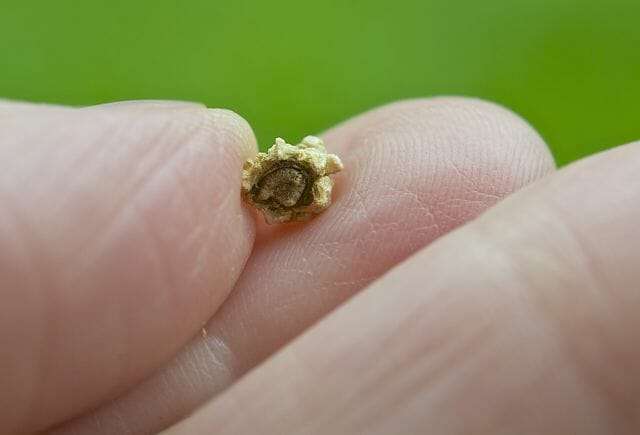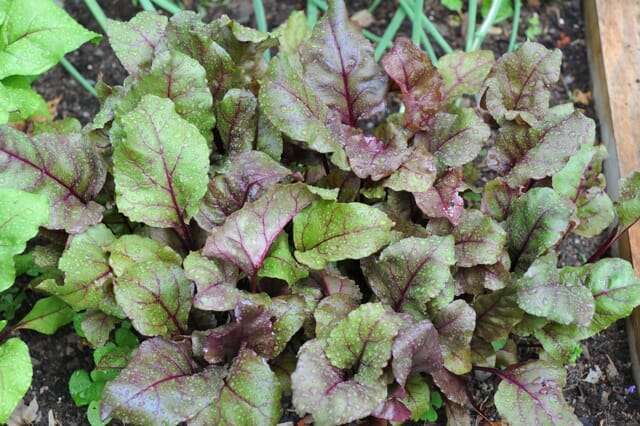how to grow beets, with brian campbell

“We would be sad if people shied away from such an iconic garden vegetable,” says Brian, who with Crystine Goldberg farms organic seed, including for beets, in Bellingham, Washington–seed they sell in their online and print Uprising catalog. “What is more beautiful than a bunch of voluptuous bright red beetroots in a harvest basket en route from the garden to the kitchen?”
All too often, our only experience with beets means the usual suspects—ubiquitous varieties like ‘Detroit Dark Red’ or ‘Early Wonder,’ or produce sold without their greens and even pre-packaged or canned. Brian confesses he doesn’t have much experience with those, and for a good reason: There are better beets to be had, and grown.
my beet-growing q&a with brian campbell
Q. When can I sow beets—what’s their timeline?
A. Beets are pretty hardy and can go in pretty early. Our last frost date [in northwest Washington] is May 15th, and they can go in the ground a good month before that.
Beets are biennials, meaning that they make the beet the first year, overwinter, and then bolt to flower and produce seed the second year. The winter is what triggers flowering, though, so if you plant your beets very early in the spring, a percentage might think they have gone though a winter and bolt before growing a full-size beetroot.
We always direct sow, and though some people transplant, we recommend that you don’t. You might get a little jump on the season by transplanting, but often you lose that jump because of transplant “shock” or recovery time, so to us it’s not worth the extra effort.
Instead, direct sow about ¼ inch deep, placing six to eight seeds per foot in rows about a foot apart. We sow every three weeks or so to ensure a steady supply, with our last planting (for the fall harvest) a week or two into July. You could still harvest baby beets from sowings made into the first week of August around here.
Q. How do I make a beet at home, such as soil prep, light requirements?
A. Beets have enormous root systems, way bigger than what you pull as the “beet,” so they appreciate fairly deep, loose, soil. Raised beds or planter boxes are great choices for the backyard or urban gardener.
Full sun is great, some shade is no problem.
Q. What about fertilizer—are beets “heavy feeders” or do they need anything special to make those big roots?
A. We have two general fertility programs that we prep beds with on our organic farm.
One is for medium feeders (including beets). It calls for a good layer of fairly concentrated local organic dairy manure fortified and composted with seed meals and chaff from local seed businesses. This is probably the equivalent of a 3-3-3 all-natural organic fertilizer or so. We till our fortified manure in prior to planting.
The other is for crops that are longstanding heavier feeders, which is the manure plus about 30 pounds per 100-foot bed of organic alfalfa pellets (a slower-release form of nitrogen). Again: Beets get the medium-feeder treatment at our place.

A. A point of confusion is that what we think of as a beet “seed” [above] is actually a dried fruit of the beet plant and contains several seeds. So you can plant one “seed” and have several plants sprout from it. Generally that results in probably more plants coming up than there is room for.
We are not big fans of thinning at seedling stage unless they come up very thick.
We usually wait until they are big enough to look tasty. Think of your “thinning” as fancy gourmet baby-beet harvesting instead. Baby beet greens with roots the size of large marbles are lovely additions to salads. The others will continue to grow in the meantime. Probably a good spacing to shoot for with your beets that will then mature to regular large size is 3-4 inches or more.
Q. Any aftercare, once they are up and growing?
A. We keep them well weeded if we can, and probably most importantly, try to keep them evenly moist throughout their growing. Beets don’t like to dry out for long periods.
A lot of the commercial hybrid varieties have pretty wimpy tops that don’t compete well with weeds. We like a tall, bushy head of greens on our beets both to shade the ground, keeping in moisture, and also to shade out the weeds as they grow.
Plus, the leaves are good to eat! Why would you want less of them? Beets and chard are botanically the same species, and the leaves have a lot in common.
Beet leaves are not quite as tender but pack a lot of character. Try them braised with olive oil and a little balsamic vinegar or chop some up and add it to your skillet cornbread batter.

A. You can pick some greens from your growing beets but I wouldn’t go overboard, as they’re feeding the roots, after all. There should be plenty for that use from the thinnings, and then to cut off the larger beetroots as you harvest them.
Q. What about storage?
A. In terms of winter food, beet roots store well for a long, long time, six months or more for us from harvest. We use perforated plastic bags in a passively cooled (mostly) underground cellar that is in the high 30’s or low 40’s F for most of the winter.
Moisture loss is the biggest problem for us, and would also be at issue in a refrigerator, where there is a lot of air circulation going on. That’s why we bag them. As long as they are in a bag, the fridge is a great place to store them.
Q. You’ve seen a lot of beets, in your work to develop really good strains of really good varieties by careful selection. Any to recommended?
A. Most people just imagine the typical red round ones, but they come in all shapes and sizes, purply red to ruby red, gold, white, round, elongated, conical…
As for varieties:
Our taste-test winner is ‘Shiraz,’ hands-down, with a full complex beet flavor and just the right sweetness [top-of-page photo of beet roots]. I think this beet will become very popular both with home and market growers in coming years. A great all-arounder with dark burgundy roots and big, healthy tops.
‘Feuer Kuegel’ (“fireball” in German) is another very dependable traditional round variety. Very vigorous, and a strong producer in trials, if a little milder in flavor than ‘Shiraz.’
For early spring planting ‘Boltardy’ or ‘Boston’ are good choices, as they are very slow to bolt after growing in cold, wintery weather.
‘Chioggia’ types are bright red on the outside and a bright red and white bullseye pattern when sliced crosswise. They are very sweet but not as full-flavored as the traditional reds. This might be our favorite beet recipe we’ve tried (using chioggias).
Gold varieties taste a bit milder than the reds but have the aesthetic appeal of not having their color bleed into whatever dish they are a part of. We have enjoyed both ‘Touchstone’ and ‘Golden Detroit.’
For canning beets, breeders have created elongated oval shaped beets that make more evenly sized sliced rounds per beet. ‘Cylindra’ is a good one.
If you have mild enough winters to store your beets in the ground, we are fond of ‘Lutz.’ It’s not “refined and elegantly round,” mind you, with its big, fat taproot and conical shape, but we are working on improving its appearance and have made some progress. It does, however, boast the biggest set of greens we have ever seen atop a beet, almost like a full chard plant with a giant beet below it.





I know that the full name for Lutz is Winterkeeper so would you follow the same planting regime for fall/winter shooting for a late July to early August sowing or could I go later. I’m a little south of you right on the 45th. parallel. How would sowing under cover (unheated hoophouse) alter the schedule if at all?
Love the catalog!!
Hi, Tim. I don’t think root crops will form roots in winter (from a fall planting in the North, I mean) — I think you can grow beet greens (tops) in the offseason under cover, for salad etc. (or just try chard instead perhaps), but I don’t think beets and carrots will size up underground from a fall planting. Two uses for them in a greenhouse: if they were grown in there from a summer sowing the little extra protection means they can “stand” in the ground longer into winter yet still be diggable, so you don’t have to dig/store them as early I’d expect. Most useful: you can get a substantial jump on a spring/summer crop of beets by making your first sowing in the hoophouse in late winter, meaning getting actual beets sooner than from the first outdoor sowing.
Like many of the winter crops the “winter” part has more to do with harvest date and storage capacity than planting dates. Lutz is actually a bit on the slow side in sizing up. I’d even recommend early to mid July for sowing in my area (NW WA) to get good storage sized roots by fall. It takes a bit of planning but its good to remember that late summer is not the time to start thinking about fall/winter gardens…a lot of those crops (Cabbages, carrots, kales, cauliflowers, some chicories) should be sown from June to early July.
We love young beet greens with or without the baby beet attached. Any variety recommended for particularly tasty greens?
Hi, CJ. Brian says ‘Lutz’ has the most prolific greens. I love the “greens” from ‘Bull’s Blood,’ which are more dark wine-colored than bright green, so extra-nutritious and beautiful, and also the ones from ‘3 Root Grex.’
thanks for the suggestions–i, too, am a huge fan of beet greens (and if it’s not heretical to say so, i’d grow beets just for the greens)
I neglected to mention the Bulls Blood. The color is indeed beautiful on those greens (reds?). I do think they are better suited to baby greens though as they can be on the tough side as full sized greens.
I think gold beets like “Touchstone” have particularly tender and tasty greens, actually
Thanks for the great interview/article. I have planted beets (from seed ;) for the first time and darn it if I didn’t thin them already! Next time. I have never eaten beet-greens before and I look forward to it!
Hi, Julie. I think they will be fine…many people do thin…but Brian is suggesting what he believes is the optimal process, waiting till the large-marble-sized babies form. I bet you will do fine, and can adjust with the next sowing and compare results. I love the greens — sort of chard-like, but a little stronger.
There’s certainly no harm in thinning and in many cases it’s beneficial. I am just of the opinion that you might as well wait until you can get some use out of he thinnings!
I’ve tried to grow beets a few times and they grow like mad … above the ground. I inevitably have tons of greens and little or no beet itself. Do you have any tips? Thanks!
Hi, Vy. Do you transplant them from cellpacks or flats into the garden? That shock can set them back and prevent formation of roots. Also: Is your soil rich enough, but not too rich (as mentioned in the article)? A very poor soil would probably not even support the “like mad” crop of greens, so I wonder: are you OVERfertilizing with too much Nitrogen, creating greens at the expense of roots? Are you thinning (removing marble-sized beets to make root for the others) or otherwise allowing enough spacing? Overcrowding will thwart root formation — as will a weedy bed (competition from weeds). Root crops hate drying out — it will check their growth and root development.
I have this problem as well, but I grow in containers. I always get great greens but very little actual beet formation. I keep them about 3-6 in apart and make sure to not give them too much nitrogen. I was wondering about the PH in the soil, is there a particular requirement for goot root formatin? I never have a problem with carrots or other root veggies, just beets! Thanks
Thank you for featuring Uprising they are my local seed supply. I like beet greens but find the roots to strong flavored, maby I should try the golden ones.
Hi Margaret,
I wouldn’t ordinarily send along another link, but this is a tongue-in-cheek essay from an online food magazine of my failed attempts at growing beets. I think your readers may appreciate it. Gardener falls flat, Sumo-Sheltie assists.
https://www.culinate.com/articles/first_person/The+beet+goes+on
Susie Troccolo
Beets were not my favorite and for a long time , I only ate them in potato salad. I loved the pink hue that they gave to the dish. Fast forward to my daughter who loves beets and has re-introduced us all to this vegetable. I just plant seeds and really didn’t realize that there were different colors.
Next planting, I will try the others.
Excellent interview. I’ll find the info on fertilizing and thinning very helpful with this years crop. Thanks
Glad to hear that, Brian, and nice of you to say hello!
I’ve read that you can soak the seed to encourage germination-do you recommend doing that?
Awesome how to article. Beets are one thing we don’t grow in our garden but if we ever do I’ll be coming back here!
What a nice article–thank you! I grew up gardening with my grandfather, who always sprinkled epsom salts along the beets rows at planting. Do you have any insight into this practice and what he was supplementing? Or if it was a natural type of pest control? He had a truck farm and grew great vegetables, so I always figured there was something to it. Thanks so much, Linda
Hi, Linda. People believe it is good for adding Magnesium (since it is Magnesium sulfate), an element plants use for various purposes.
In 2017 I habitually used epsom salts on my serrano peppers at least once a week 1 tablespoon per gallon of water and put 1 pint on each of my 16 plants and have had 3 great harvest till august 29th and still have a great harvest coming with many 100 blossoms aswell,but please remember I have two 55 gallon plastic garbage cans filled with water that I add alot of comfrey leaves from my comfrey hedge that I always water them with always aswell as my tomato plants with molasses added once in awhile and I have an abundant harvest many fruits and blossoms on healthy plants!!But I always periodically foliar spray them with 1 gallon of of water with 1 325 milligram aspirin(asylic acid that picks up the plants immune system) puried in blender with warm water but don’t forget to add veggy oil or olive oil with a 1 teaspoon of dawn dish liquid so it clings to plant leaves so it it don’t run right off and then be useless!! I had so many blossoms at end of this season I had to eliminte some of them on the tomato plants so the rest of my tomatoes had enough energy to ripen before our first frost around October 10th to 20th cause they say to do this about 1 to 1 1/2 monthes before first frost to give the formed tomatoes time and enery to ripen!!!!
Sorry I forgot to add I do exactly the same thing to my beets aswell with great results except for them I don’t add Aspirin and am having great results with them aswell good luck I hope all this info helps your produce in your gardens greatly!!I do the same thing with all my squash aswell minus the aspirin with great results!Please don’t take me wrong I am not saying this to brag I am only sharing it hoping to assit you in you crop heaven!!
If you need to add sand to soil for carrots, what kind of sand do you get?